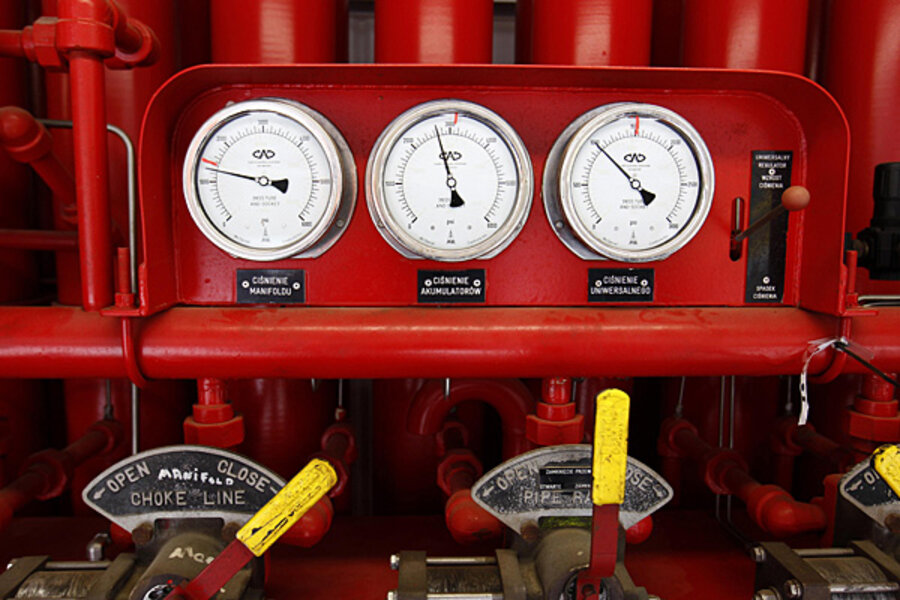Can anyone break Russia's hold on Europe's gas?
Loading...
They say you have to give the customers what they want.
In Europe, they want cheaper natural gas to jumpstart an economy crippled by high energy costs. They aren't getting what they want from their current suppliers – namely Russia, which provides Europe with almost a third of its gas. But the global energy landscape is shifting, loosening Russia's tight grip on European markets.
"The European gas market at this moment is somewhat depressed due to its economy," David Goldwyn, former special envoy for international energy affairs under Secretary of State Hillary Clinton, said in a telephone interview. "With demand relatively flat, increasing shares of renewables from the EU renewables mandate, and increasing [liquefied natural gas] import capability, Europeans have more choices than they used to."
In June, Norway overtook Russia as Europe's leading gas supplier. This week, the US authorized the third liquefied natural gas (LNG) export terminal in a year, with an eye toward overseas markets. But all eyes are on the Caspian Sea and the eastern Mediterranean Sea as the next big thing in natural gas for energy-hungry Europe and Asia.
The trouble is, getting gas from the myriad countries eager to sell to Europe is easier said than done. Delicate geopolitics, civil unrest, crooked deals, and the sheer logistics of transporting the gaseous fuel stand in the way. The most probable alternative to Russian gas might be right under Europeans' noses.
Ultimately, the trend is toward a more diverse gas mix for Europe, experts say. It just may not happen anytime soon, and it's unclear who stands to benefit.
"No one will win, Russia will just lose," wrote Daniel Freifeld, founder of Permian International, an investment firm specializing in energy and infrastructure. That has less to do with who builds the biggest pipeline to Europe and more to do with broader economics and politics, according to Mr. Freifeld, who previously served as senior adviser to the special envoy for Eurasian energy at the US Department of State.
"Europe could win slightly with liberalization of third party access, unbundling, ... and construction of interconnectors," Freifeld wrote in an e-mail, "but I don't believe any particular state is going to 'win.'"
Don't tell that to Azerbaijan or Kazakhstan or any of the five countries bordering the Caspian Sea. There's 292 trillion cubic feet of natural gas in proved and probable reserves in the region, according to the US Energy Information Administration. But it takes a lot of investment to move the product from the Caspian to distant markets, and Russia will do all it can to squelch potential competition from the former Soviet satellites.
Turkey is littered with abandoned dreams of pipelines through a "Southern Gas Corridor" that would connect eastern Europe with the Caspian region and the Middle East. The best bet is on the Trans-Adriatic Pipeline, which this summer was selected to deliver gas from Azerbaijan via Greece, Albania, Italy, and onto Western Europe. It has the backing of the US, which has been working since the Clinton to administration to see a Eurasian link.
"While the Southern Gas Corridor focuses on supplies to Europe, it also represents an important contribution to global energy security," Patrick Ventrell, a State Department spokesman, wrote in a statement in June. "By bringing Caspian gas to international markets, this initiative will contribute to meeting global energy demand, which is critical to sustaining economic growth."
Iran holds the world's second largest reserves of natural gas, behind Russia, but international sanctions have crimped its ability to capitalize on its Persian Gulf resources. The fate of a pipeline from Iran through Iraq to Syrian ports looks doubtful, given the turmoil in that country under President Bashar al-Assad. Qatar also stands to benefit from exporting Persian Gulf natural gas, but Syria has so far blocked one proposed path to Mediterranean ports. And growing instability in the region makes it harder for countries on the eastern Mediterranean coast to develop the gas-rich Levant Basin.
Then there's the US. The North American shale gas boom is driving a push for terminals to export liquefied natural gas overseas. After three idle years, the Department of Energy is beginning to approve the backlog of applications. But it's an expensive way to move fuel and it will be years before most of those terminals come online.
The easiest alternative might be in Europe's own backyard. Shale deposits in the United Kingdom, Poland, and elsewhere offer the possibility that America's fracking boom can be replicated on the other side of the Atlantic, if Europeans are willing to accept the effective but controversial drilling technique called hydraulic fracturing. So far, much of the response to plans to develop local resources has been, "not in my backyard."
In other words, Russia's outsize role in supplying gas to Europe is likely to persist albeit with less pricing power. Growing demand for gas in Europe will outstrip new sources of supply, according to a July analysis by Reuters, and Russia will continue to supply 30 percent of Europe's gas through 2023.
"There will still be a dominant role for Russia in the gas market," said Mr. Goldwyn, currently president of Goldwyn Global Strategies, a Washington-based energy analysis firm, "but competition from LNG, indigenous gas, and possible rerouting of other sources is going to continue to erode the price Russia is able to earn from its gas."






